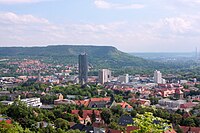TheJenToweris askyscraperinJena,Germany.


Common names
editThe tower has been known by many names, official and unofficial. From 1992 until January 2005, the tower was called theIntershop Towerafter its principal tenant,Intershop Communications AG.On November 30, 2004, the building was renamed the JenTower. Until 1995 the building was used by the Friedrich SchillerUniversity of Jena,and therefore it is still colloquially known as the University Tower.
Further unofficial names includePhallusJenensis,CookieRoll (Keksrolle), University Tower (Uniturm) or the Henselmann tower, after the architectHermann Henselmann.Often it is just calledthe tower.
Buildings in vicinity
editThe JenTower stands directly opposite to the so-called Building 15, which was the first German highrise building. Building 15 was erected in to a height of 43 meters in 1915, based on plans by the architectFriedrich Puetzer(1871–1922). Other buildings in the neighborhood are Building 36 (today seat of theJenoptik) and Building 59 (CarlZeissJena Research building), likewise designed by Henselmann.
Construction
editThe architect of the tower wasHermann Henselmann,one of the most famous architects of the formerGerman Democratic Republic.The idea of a monolithic tower as an "urban crown" was developed byBruno Taut,who was city architect inMagdeburgin the 1920s.
Construction began in June 1969, in a residential and business quarter spared by theSecond World War.The foundation stone was laid on April 30, 1970. Construction took place insliding scarfbuilding method, and was completed on October 2, 1972 at the original height of 127 meters. The circular tower is areinforced concreteconstruction with two basements, a 3.20-meter-thick mat foundation and a diameter of 33 meters.
In 1968‐1969 there were also state plans to build a recreation center for VEB Zeiss workers next to the tower. This additional building would have displaced the historical Collegium Jenesecloister.These plans were scrapped due to protests of the locals, in particular those of microbiologistHans Knöll,and due to the poor financial shape of VEB Zeiss at the time. Even the tower itself proved too expensive for VEB Zeiss to maintain, and it was moved into the property of theUniversity of Jenaafter it was completed, despite the University's protestations.[1]
In 1999 the building was sold to an investor, who completed a modernization in 2001. At this time, two additional floors and aUMTSantennawere added, and the 28th and 29th floors were converted into a restaurant. Including the antenna the tower reaches 159 meters. The building was the second tallest inEast Germanyafter the City Hochhaus Leipzig, and after two additional stories were added in 2001, became the tallest in former East Germany. It is currently the28th-highest in Germany.All 25 that are taller are in formerWest Germany.
See also
editReferences
edit- ^Heckart, B. (May 2006). "The Battle of Jena: Opposition to" Socialist "Urban Planning in the German Democratic Republic".Journal of Urban History.32(4): 546–581.doi:10.1177/0096144205284163.